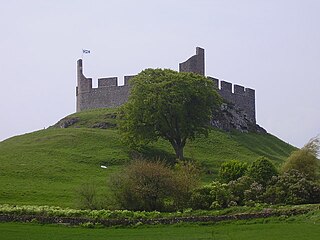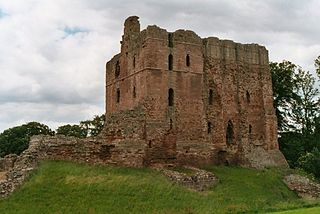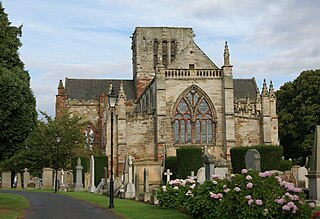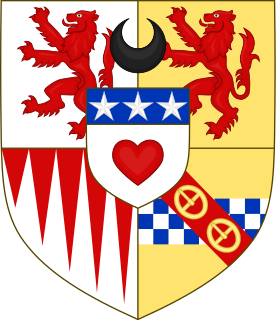
Sir Brian Layton, also spelled Laiton, Leyton, or Leighton, (died 27 February 1545) was an English soldier and Captain of Norham Castle.

Sir Brian Layton, also spelled Laiton, Leyton, or Leighton, (died 27 February 1545) was an English soldier and Captain of Norham Castle.
As Captain of Norham, Layton watched the border between Scotland and England. In December 1539, his men tracked the English priest Dr Hilliard, who was fleeing into Scotland. Layton's men arrested Hilliard's servant, but Hilliard crossed the Tweed near Coldstream. Layton's spies in Scotland discovered that Hilliard was received by the Prioress of Coldstream and hoped to meet David Beaton. [1] In April 1540, Layton saw fires lit in Scottish villages on the night of Trinity Sunday which celebrated the birth of the son of Mary of Guise and James V of Scotland. On the same day, he questioned a Scottish man about the secret plans of James V for a sea voyage. [2]
In October 1542, Layton was troubled by rumours of a plot by members of his own garrison at Norham to hand the castle over to the Scots. He questioned suspected soldiers, and sent reports to Cuthbert Tunstall, Bishop of Durham, which give useful historical information about the castle and the routine of the garrison. [3]
Layton rode with the force of border horseman to the burning of Edinburgh (1544). He and Ralph Eure commanded an English invasion of Scotland during the War of the Rough Wooing in February 1545. The soldiers destroyed tombs of the Douglas family at Melrose Abbey. [4] Layton and Eure were both killed at the Battle of Ancrum Moor. [5]
Broughty Castle is a historic castle on the banks of the River Tay in Broughty Ferry, Dundee, Scotland. It was completed around 1495, although the site was earlier fortified in 1454, when George Douglas, 4th Earl of Angus, received permission to build on the site. His son, Archibald Douglas, 5th Earl of Angus, was coerced into ceding the castle to the crown. The main tower house forming the centre of the castle with four floors was built by Andrew, 2nd Lord Gray, who was granted the castle in 1490.

The Battle of Solway Moss took place on Solway Moss near the River Esk on the English side of the Anglo-Scottish border in November 1542 between English and Scottish forces.
Sir Richard Lee (1513–1575) was a military engineer in the service of Henry VIII of England, Edward VI and Elizabeth I. He was a commander of Henry VIII and appointed surveyor of the King's works. Lee was member of parliament for Hertfordshire in 1545. He was the first English engineer to be knighted.
The Battle of Ancrum Moor was fought during the War of the Rough Wooing in 1545. The Scottish victory put a temporary end to English incursions in the Scottish border and lowlands. The battlefield has been included in the Inventory of Historic Battlefields in Scotland and protected by Historic Scotland under the Historic Environment (Amendment) Act 2011.

Dunbar Castle was one of the strongest fortresses in Scotland, situated in a prominent position overlooking the harbour of the town of Dunbar, in East Lothian. Several fortifications were built successively on the site, near the English-Scottish border. The last was slighted in 1567; it is a ruin today.
Berwick Pursuivant of Arms in Ordinary was an English office of arms created around 1460 for service on the Scottish Marches based at Berwick-upon-Tweed. In the 16th century there was also a Herald or Pursuivant based at Carlisle on the west border.

Hume Castle is the heavily modified remnants of a late 12th- or early 13th-century castle of enceinte held by the powerful Hume or Home family, Wardens of the Eastern March who became successively the Lords Home and the Earls of Home. The village of Hume is located between Greenlaw and Kelso, two miles north of the village of Stichill, in Berwickshire, Scotland.. It is a Scheduled Ancient Monument, recorded as such by Historic Environment Scotland.

Norham Castle is a castle in Northumberland, England, overlooking the River Tweed, on the border between England and Scotland. It is a Grade I listed building and a Scheduled Ancient Monument. The castle saw much action during the wars between England and Scotland.

Sir John Luttrell feudal baron of Dunster in Somerset, of Dunster Castle, was an English soldier, diplomat, and courtier under Henry VIII and Edward VI. He served under Edward Seymour, Earl of Hertford in Scotland and France. His service is commemorated in an allegorical portrait by Hans Eworth.

The Sieges of Haddington were a series of sieges staged at the Royal Burgh of Haddington, East Lothian, Scotland, as part of the War of the Rough Wooing, one of the last Anglo-Scottish Wars. Following Regent Arran's defeat at the battle of Pinkie Cleugh on Saturday 10 September 1547, he took Haddington, with 5000 troops including French mercenaries and troops sent by Henry II of France to bolster the Auld Alliance. Afterwards, Francis Talbot, 5th Earl of Shrewsbury took it with nearly 15,000. The English forces built artillery fortifications and were able to withstand an assault by the besieging French and Scots troops supported by heavy cannon in July 1548. Although the siege was scaled down after this unsuccessful attempt, the English garrison abandoned the town on 19 September 1549, after attrition by Scottish raids at night, sickness, and changing political circumstance.

The Rough Wooing, originally known as the Eight Years' War, was part of the Anglo-Scottish Wars of the 16th century between Scotland and England. Following its break with the Roman Catholic Church, England attacked Scotland, partly to break the Auld Alliance and prevent Scotland being used as a springboard for future invasion by France, partly to weaken Scotland, and partly to force the Scottish Parliament to confirm the existing marriage alliance between Mary, Queen of Scots, and the English heir apparent Edward, son of King Henry VIII, under the terms of the Treaty of Greenwich of July 1543. An invasion of France was also contemplated. Henry declared war in an attempt to force the Scottish Parliament to agree to the planned marriage between Edward, who was six years old at the start of the war, and the infant queen, thereby creating a new alliance between Scotland and England. Upon Edward's accession to the throne in 1547 at the age of nine, the war continued for a time under the direction of the Duke of Somerset, before Somerset's removal from power in 1549 and replacement by the Duke of Northumberland, who wished for a less costly foreign policy than his predecessor. It was the last major conflict between Scotland and England before the Union of the Crowns in 1603.

The Battle of Glasgow was fought on 16 March 1544, between Matthew Stewart, 4th Earl of Lennox and the Scottish Regent James Hamilton, 2nd Earl of Arran, and their adherents, during the minority of Mary, Queen of Scots. There was a second battle at Glasgow Muir in May 1544 between Arran and the Earl of Glencairn.

George Douglas of Pittendreich was a member of the powerful Red Douglas family who struggled for control of the young James V of Scotland in 1528. His second son became James Douglas, 4th Earl of Morton and Regent of Scotland. Initially, George Douglas promoted the marriage of Mary, Queen of Scots and Prince Edward of England. After war was declared between England and Scotland he worked for peace and to increase the power of Mary of Guise, the widow of James V.
Sir Ralph Bulmer of Wilton in Yorkshire, was an English knight and soldier active on the Scottish border and during the war of the Rough Wooing.

William Eure, 1st Baron Eure (c.1483–1548) of Witton was an English knight and soldier active on the Anglo-Scottish border. Henry VIII of England made him Baron Eure by patent in 1544. The surname is often written as "Evers". William was Governor of Berwick upon Tweed in 1539, Commander in the North in 1542, Warden of the Eastern March, and High Sheriff of Durham. During the Anglo-Scottish war called the Rough Wooing, Eure and his sons Henry and Ralph made numerous raids against towns and farms in the Scottish Borders.
The Burning of Edinburgh in 1544 by an English sea-borne army was the first major action of the war of the Rough Wooing. A Scottish army observed the landing on 3 May 1544 but did not engage with the English force. The Provost of Edinburgh was compelled to allow the English to sack Leith and Edinburgh, and the city was burnt on 7 May. However, the Scottish artillery within Edinburgh Castle harassed the English forces, who had neither the time nor the resources to besiege the Castle. The English fleet sailed away loaded with captured goods, and with two ships that had belonged to James V of Scotland.

The siege of St Andrews Castle (1546–1547) followed the killing of Cardinal David Beaton by a group of Protestants at St Andrews Castle. They remained in the castle and were besieged by the Governor of Scotland, Regent Arran. However, over 18 months the Scottish besieging forces made little impact, and the Castle finally surrendered to a French naval force after artillery bombardment. The Protestant garrison, including the preacher John Knox, were taken to France and used as galley slaves.
Alexander Crichton of Brunstane,, was a Scottish Protestant laird who advocated the murder of Cardinal David Beaton and supported the plan for the marriage of Mary, Queen of Scots and Prince Edward of England. In contemporary letters and documents Alexander is known by variant spellings of "Brunstane," his territorial designation. The original House of Brunstane was near Penicuik, and another Crichton estate at Gilberstoun near Portobello, Edinburgh later became known as Brunstane.

Wark on Tweed Castle, sometimes referred to as Carham Castle, is a ruined motte-and-bailey castle at the West end of Wark on Tweed in Northumberland. The ruins are a Grade II* listed building.
Bedrule Castle is a ruined 13th-century castle in the Rule Valley, in the Scottish Borders area of Scotland.